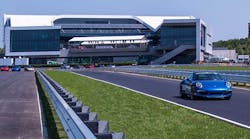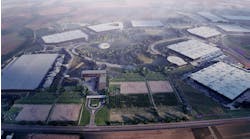The Southeast region of the country is seeing quite a manufacturing boom. Airbus opened its first U.S. plant last month in Mobile, Ala. calling it the company’s flagship site in the U.S.
Why Alabama? “It gives them a larger industrial presence, which could be useful in pursuing defense contracts,” explains Richard Aboulafia of the Teal Group Corp. “It puts pressure on trade unions back in Europe, because labor in Alabama costs less. And it diversifies their currency exposure, which could be useful if the euro gets strong again.”
The manufacturing base of this region was created in large part by the auto industry. In fact Atlanta has been dubbed “Stuttgart West” thanks to its position as the U.S. headquarters of German companies. Home to the newly revamped Porsche Cars North America headquarters — complete with a test track near the airport — it also lured the Mercedes-Benz USA head office away from another location. And BMW’s largest production plant in the world is in South Carolina.
Other auto manufacturers are represented as well. Kia Motors has a large Georgia production facility and Honda and Hyundai both have major operations in Alabama.
It’s not just the automotive industry that is attracted to the Southeast. Lenovo, the world’s leading PC vendor, opened its first U.S. manufacturing plant in North Carolina last year. Starbucks even roasts its coffee beans in South Carolina. And Google recently-announced plans to invest $600 million into a new data center in Alabama.
To find out why this area is attracting so many manufacturing companies, IndustryWeek talked to William “Lee” Thuston, a 30-year veteran in Southeastern economic development and managing partner of Burr & Forman (Birmingham, Ala.). He has assisted economic development projects representing an estimated $17 billion of capital investment and over 26,000 new jobs. Thuston was involved in the site selection process for Mercedes-Benz U.S. International, Inc. Honda Manufacturing of Alabama, Hyundai Motor Manufacturing Alabama, LLC, KIA Motors Corp. Mi-Tech Steel, Inc, IPSCO Steel and ThyssenKrupp.
Q: Given the issue of talent scarcity, how are manufacturing companies finding the talent to staff the continual growth that is occurring in the area?
A: The issue of talent in this area is very interesting and different from other locations. Given that we have had so much success in this region we have somewhat drained our supply of skilled workers.
An example of this is when Mercedes announced in 1993 it was moving to this area a lot of suppliers in Michigan held back from locating here waiting to see if other auto companies would follow. Now everyone understands that this industry is firmly established in the area so more companies are moving in and placing a strain on the availability of talent.
To solve the issue manufacturers are collaborating with universities, junior colleges and trade schools. They are working with state training agencies as well. We must look at different models. Some states offer free college tuition to students.
And the industry must do a better job of promoting itself. High school guidance counselors should tour factories so that they can suggest this field to students. We should bring students in for tours. We have to convey to our younger workers that manufacturing offers good-paying jobs with upward mobility.
Q: What specific programs are being used to train workers?
A: In Alabama, for example, there is the AIDT (Alabama Industrial Development Training) program. Its services include trainee recruitment and screening, safety assistance, industrial maintenance assessments and continuous improvement/process improvement assessments. They are now revamping some programs to focus more on manufacturing. One particular area of focus is the skill to repair robots. There is a shortage of workers in this area.
There is also a focus on providing training to adults and attending post-secondary schools or private training institutions. Employers can receive 50% hourly pay reimbursement for training participants.
Q: How is the need for a strong supply chain affecting the region?
OEMs want suppliers here due to their just-in-time manufacturing process. Once suppliers for a specific OEM locate here they end up supplying other OEMs. For example Korean suppliers working with Hyundai are now also working with Kia.
And the talent supply chain has also become diversified as a result of the many global companies locating here. We have foreign nationals from Germany, Japan, Korea, Belgium and France. This area embraces the variety of cultures and often many foreign nationals end up staying.
Q: Will the infrastructure support the continued expansion?
A: Yes, the Southeast has a large railroad infrastructure. Intermodal stations are being built up and down the East coast. The area is expecting a large influx in all ports due to the increase shipping volume through the Panama Canal and is working to accommodate the new traffic. In fact when the Panama Canal expansion is completed in 2016, ports in this region are expecting a 10% shift in traffic coming from Asia from the West Coast to the East Coast.
And traffic will increase from the Southeast to Asia. In fact Mercedes ships its R-class from Mobile to China and is the largest exporter in the state.
In addition to a strong interstate system and the strength of the Atlanta airport, there is also undeveloped land available to accommodate expansion.
Q: Why does this area have a reputation for being business-friendly?
A: One of the biggest reasons is the right to work status of the states in this region.
Other factors include, lower or no income taxes, affordable cost of living and an overall attractive place to raise families, thanks to the climate and lifestyle.
And there is an intangible factor as well. As you know often companies conduct undercover visits to the area to get a feel for the place. They want to know if they and their employees would feel comfortable living in the area. They go to restaurants, grocery stores and other places and talk to people. What I’ve been told by some of my clients is that they getting a feeling that it’s easy to get along with the people here. But more importantly they can trust people here. And it turns out that’s an important factor in the decision-making process.




